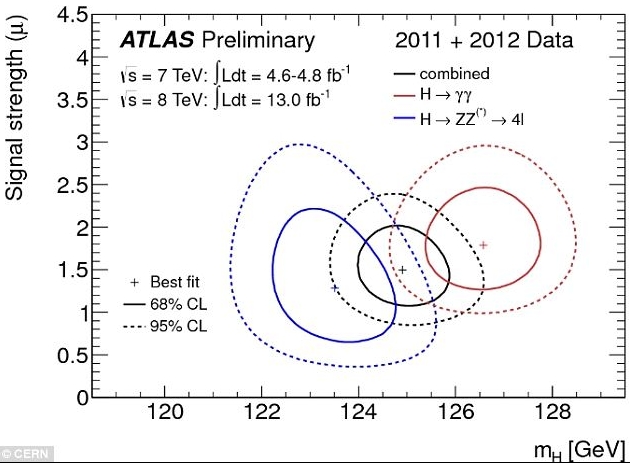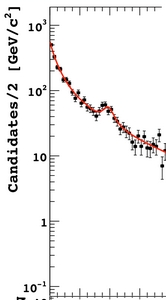The branching ration of the Standard Model Higgs boson into muon pairs is a 10^-5 thing, so no more than one or two events could appear in the statistics so far collected, and these would be drowned in the Drell-Yan continuum background: so a signal observed today cannot really be a Standard Model thing. Yet a narrow bump in a smooth background distribution has been found and the log-likelihood ratio of the alternate to null hypothesis provides a significance estimate at the level of just above four standard deviations (the estimate was 4.4σ but I believe it has been slightly reduced just before sending the article, during final reading) .
The significance quoted above is "local", which means that the multiplicity of places where the signal has been sought is not taken into account in its computation. When the look-elsewhere effect is considered (the search spans a wide mass range from above the Z boson mass, 91 GeV, up to 600 GeV) the global significance of the observed bump is no more than a 2.9 standard deviations effect - that is because the mass resolution of muon pairs in CMS is very good, so that the number of independent places where a bump could be fit in a 510-GeV-wide mass spectrum is of the order of 100. And yet...
Yet the mass at which the signal is found is not random: the signal is seen at a mass of 123.5 GeV, which is quite close to one of the two Higgs boson signals found by the ATLAS collaboration in their most recent measurements! So whether to apply the look-elsewhere correction or not to this signal is quite arguable. I would actually claim that no such correction is needed in this case, but the title of the article is "Preliminary Evidence for a Narrow Resonance in the Search for the Muon-Pair Decay of Higgs Bosons" - my CMS colleagues decided to play it safe this time.
A rather unforeseen scenario is disclosing in front of us. Could it be that the ATLAS detector, with its better energy resolution, had been able to see the signal of two distinct states, and now CMS is observing, with its very high-resolution dimuon mass reconstruction, the higher-mass one ? If two supersymmetric objects have masses close to each other, that does not mean that their branching fractions need to be the same: a few theorists have in fact speculated some months ago that one of the two states might decay with an enhanced branching fraction to photon pairs, and the other might have an enhanced rate of decays to fermion pairs, such as muon pairs. If that is the case, I am losing three 100$ bets... But I would be quite happy to have to pay them!

The figure above shows the mass measurements performed recently by ATLAS, showing two distinct peaks in the probability distribution, one populated by the H->gamma gamma pairs, the other by the ZZ decays.
 I cannot disclose more details of the analysis (and am already at fault with the information I am providing right now) because as far as I see the result is not appearing in the arxiv just yet -probably because today is a holiday. However the result is technically public already, so I figure I can paste here a clip of the mass spectrum which shows the bump. If I cut out the x and y axes I am not disclosing any quantitative information yet... Anyway I am sure I will be able to post more details soon, I find out whether we already have a public web page with all the plots... Stay tuned!
I cannot disclose more details of the analysis (and am already at fault with the information I am providing right now) because as far as I see the result is not appearing in the arxiv just yet -probably because today is a holiday. However the result is technically public already, so I figure I can paste here a clip of the mass spectrum which shows the bump. If I cut out the x and y axes I am not disclosing any quantitative information yet... Anyway I am sure I will be able to post more details soon, I find out whether we already have a public web page with all the plots... Stay tuned!UPDATE: of course the alert readers have figured out that this was just an April Fool... Sorry - there is only one Higgs signal!




Comments